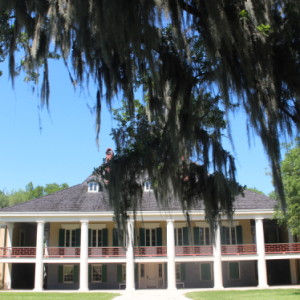Longue Vue House and Gardens
Friday
This morning, we visited Longue Vue house and gardens, located on the western edge of the city. The home was built for the late philanthropists Edgar Bloom Stern, a New Orleans businessman and cotton broker, and his wife Edith Rosenwald Stern, an heiress of the Sears department store family. The current house is in fact the second they built on the site. The original house and gardens were begun in 1924. In 1934, landscape architect Ellen Biddle Shipman began to work with the Sterns on the designs of their gardens. Through the re-working of the gardens the Sterns decided that their current house did not allow them to fully enjoy their new grounds, so they had the original house moved and a new one erected in its place starting in 1939! You are shown around the house by a tour guide, who was very informative. The gardens which extend over 8 acres, are beautiful, and were actually being filmed by a film crew from the BBC while we were there!
From Longue Vue, we left New Orleans, and moved a little way west of the city into the plantation country. The river road these days is an interesting juxtaposition of beautiful plantation homes, interspersed with huge, less than attractive petrochemical plants! The plantation home we saw this afternoon was the Destrehan Plantation. One of the oldest plantation homes in Louisiana, Destrehan Plantation was originally constructed beginning in 1787 and completed in 1790, during the period of Spanish rule. It was worked originally as an indigo plantation and later for sugar cane. It’s a wonder it stands at all, as in 1914, the Mexican Petroleum Company, a predecessor of American Oil Company, bought the property and built an oil refinery. All the ancillary housing around the main house were torn down to make way for employee housing. The mansion itself was used in a variety of ways including as a clubhouse. In 1959, American Oil tore down the refinery, abandoning the site, and during the following 12 years the mansion fell into decay. Due in part to an old legend that the privateer Jean Lafitte had hidden treasure in the house, treasure-seekers left gaping holes in the walls, and vandals stripped the building of its Italian-marble mantels, cypress paneling, Spanish-style ceramic tiles, and glass window panes, leaving not much more than the shell. However, in 1971, American Oil donated the house and 4 acres of land to the River Road Historical Society, a nonprofit organization which, through its volunteer efforts, was able to raise sufficient funds to halt the process of decay at the former plantation, ultimately restoring the house and grounds to their former beauty. Recent efforts have focused on authentically re-creating the plantation community which would have surrounded the manor house. I have included several photographs of the plantation in extras.




Comments
Sign in or get an account to comment.


